HLSC606 Semester 2, 2019: Workforce Management Reflective Essay
VerifiedAdded on 2022/09/22
|7
|1968
|19
Essay
AI Summary
This reflective essay examines workforce management within the context of the Royal Melbourne Hospital (RMH). The essay explores the critical role of mission, vision, and values in delivering high-quality and safe patient care, emphasizing the importance of aligning employee goals with organizational objectives. The author reflects on personal experiences at RMH, highlighting the hospital's commitment to research, innovation, and employee wellbeing. The essay discusses the impact of RMH's mission, vision, and values on patient safety, the reduction of waiting lists, and the development of a patient-focused care system. The author also learned about how RMH's mission, vision, and values guide the workforce in delivering safe and quality care to patients. The essay concludes by underscoring the significance of workforce management principles, including employee training, optimized productivity, and the implementation of workforce plans, in achieving positive patient outcomes. This assignment is contributed by a student and available on Desklib.
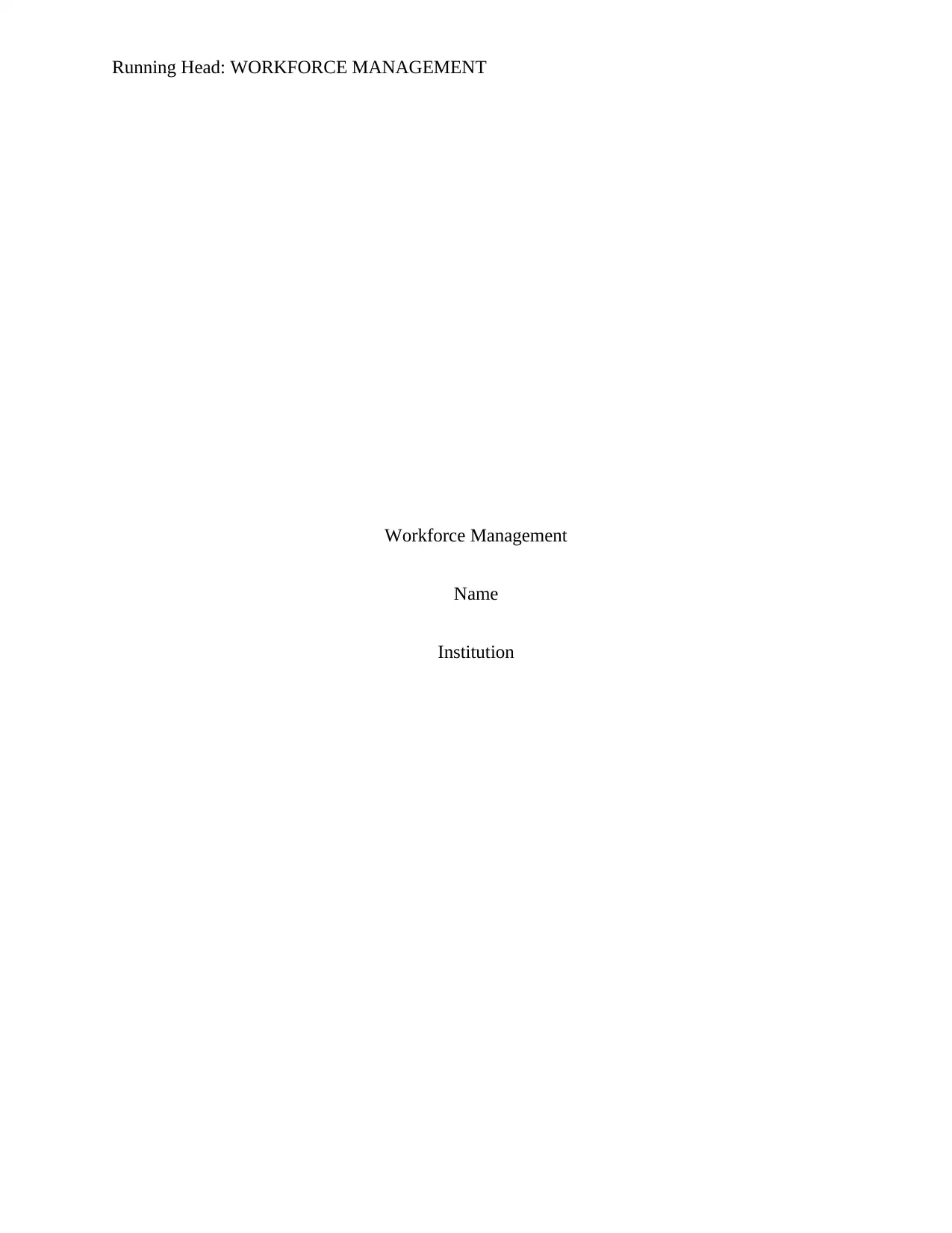
Running Head: WORKFORCE MANAGEMENT
Workforce Management
Name
Institution
Workforce Management
Name
Institution
Paraphrase This Document
Need a fresh take? Get an instant paraphrase of this document with our AI Paraphraser

WORKFORCE MANAGEMENT 2
Workforce Management
Introduction
For the past three decades, hospitals have made endeavours to support mission, vision,
and values to guarantee premium, high-value, as well as ethical care, where the workforce plays
a leading role. Leaders in health organizations have the role of aligning the mission, vision, and
values towards delivering quality and safe care to patients where the employees play a leading
role. The mission and vision of a hospital play a primary role in allowing the employees to offer
quality and safe care. The mission, vision, as well as values guide the organization in ensuring
that they continue delivering quality care to patients and the community. Royal Melbourne
Hospital (RMH) is among the best healthcare facilities situated in Parkville, Victoria, which is an
inner commune of Melbourne. Royal Melbourne Hospital is one of Australia’s principal public
health facilities. The facility is a primary teaching facility for tertiary healthcare with a reputation
in clinical research. Established in 1848, the hospital is one of Victoria’s leading clinical and
teaching health facilities. The mission of RMH is to be First in Care, Research and Learning,
while the vision is a passion for caring. Hence, values of RMH include respect, caring, unity,
discovery, and integrity. The mission, vision, and values have been central in enabling the
hospital to deliver safe and quality care and teaching to the community and consumers (Moghal,
2012). I choose Royal Melbourne Hospital since it employees pay attention to the mission,
vision, and values towards delivering safe and quality care and teaching to its clients.
Reflection
Workforce Management
Introduction
For the past three decades, hospitals have made endeavours to support mission, vision,
and values to guarantee premium, high-value, as well as ethical care, where the workforce plays
a leading role. Leaders in health organizations have the role of aligning the mission, vision, and
values towards delivering quality and safe care to patients where the employees play a leading
role. The mission and vision of a hospital play a primary role in allowing the employees to offer
quality and safe care. The mission, vision, as well as values guide the organization in ensuring
that they continue delivering quality care to patients and the community. Royal Melbourne
Hospital (RMH) is among the best healthcare facilities situated in Parkville, Victoria, which is an
inner commune of Melbourne. Royal Melbourne Hospital is one of Australia’s principal public
health facilities. The facility is a primary teaching facility for tertiary healthcare with a reputation
in clinical research. Established in 1848, the hospital is one of Victoria’s leading clinical and
teaching health facilities. The mission of RMH is to be First in Care, Research and Learning,
while the vision is a passion for caring. Hence, values of RMH include respect, caring, unity,
discovery, and integrity. The mission, vision, and values have been central in enabling the
hospital to deliver safe and quality care and teaching to the community and consumers (Moghal,
2012). I choose Royal Melbourne Hospital since it employees pay attention to the mission,
vision, and values towards delivering safe and quality care and teaching to its clients.
Reflection
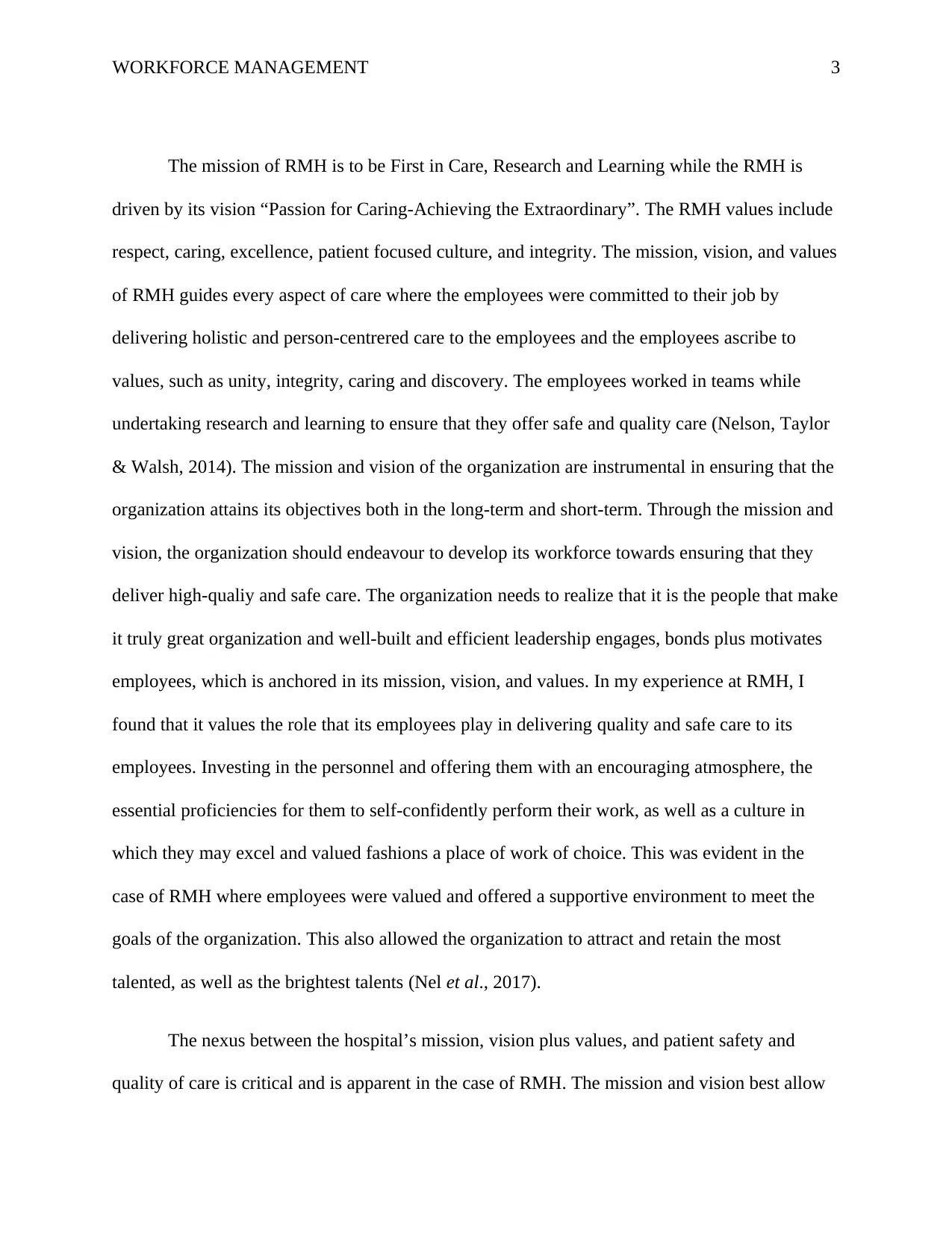
WORKFORCE MANAGEMENT 3
The mission of RMH is to be First in Care, Research and Learning while the RMH is
driven by its vision “Passion for Caring-Achieving the Extraordinary”. The RMH values include
respect, caring, excellence, patient focused culture, and integrity. The mission, vision, and values
of RMH guides every aspect of care where the employees were committed to their job by
delivering holistic and person-centrered care to the employees and the employees ascribe to
values, such as unity, integrity, caring and discovery. The employees worked in teams while
undertaking research and learning to ensure that they offer safe and quality care (Nelson, Taylor
& Walsh, 2014). The mission and vision of the organization are instrumental in ensuring that the
organization attains its objectives both in the long-term and short-term. Through the mission and
vision, the organization should endeavour to develop its workforce towards ensuring that they
deliver high-qualiy and safe care. The organization needs to realize that it is the people that make
it truly great organization and well-built and efficient leadership engages, bonds plus motivates
employees, which is anchored in its mission, vision, and values. In my experience at RMH, I
found that it values the role that its employees play in delivering quality and safe care to its
employees. Investing in the personnel and offering them with an encouraging atmosphere, the
essential proficiencies for them to self-confidently perform their work, as well as a culture in
which they may excel and valued fashions a place of work of choice. This was evident in the
case of RMH where employees were valued and offered a supportive environment to meet the
goals of the organization. This also allowed the organization to attract and retain the most
talented, as well as the brightest talents (Nel et al., 2017).
The nexus between the hospital’s mission, vision plus values, and patient safety and
quality of care is critical and is apparent in the case of RMH. The mission and vision best allow
The mission of RMH is to be First in Care, Research and Learning while the RMH is
driven by its vision “Passion for Caring-Achieving the Extraordinary”. The RMH values include
respect, caring, excellence, patient focused culture, and integrity. The mission, vision, and values
of RMH guides every aspect of care where the employees were committed to their job by
delivering holistic and person-centrered care to the employees and the employees ascribe to
values, such as unity, integrity, caring and discovery. The employees worked in teams while
undertaking research and learning to ensure that they offer safe and quality care (Nelson, Taylor
& Walsh, 2014). The mission and vision of the organization are instrumental in ensuring that the
organization attains its objectives both in the long-term and short-term. Through the mission and
vision, the organization should endeavour to develop its workforce towards ensuring that they
deliver high-qualiy and safe care. The organization needs to realize that it is the people that make
it truly great organization and well-built and efficient leadership engages, bonds plus motivates
employees, which is anchored in its mission, vision, and values. In my experience at RMH, I
found that it values the role that its employees play in delivering quality and safe care to its
employees. Investing in the personnel and offering them with an encouraging atmosphere, the
essential proficiencies for them to self-confidently perform their work, as well as a culture in
which they may excel and valued fashions a place of work of choice. This was evident in the
case of RMH where employees were valued and offered a supportive environment to meet the
goals of the organization. This also allowed the organization to attract and retain the most
talented, as well as the brightest talents (Nel et al., 2017).
The nexus between the hospital’s mission, vision plus values, and patient safety and
quality of care is critical and is apparent in the case of RMH. The mission and vision best allow
⊘ This is a preview!⊘
Do you want full access?
Subscribe today to unlock all pages.

Trusted by 1+ million students worldwide
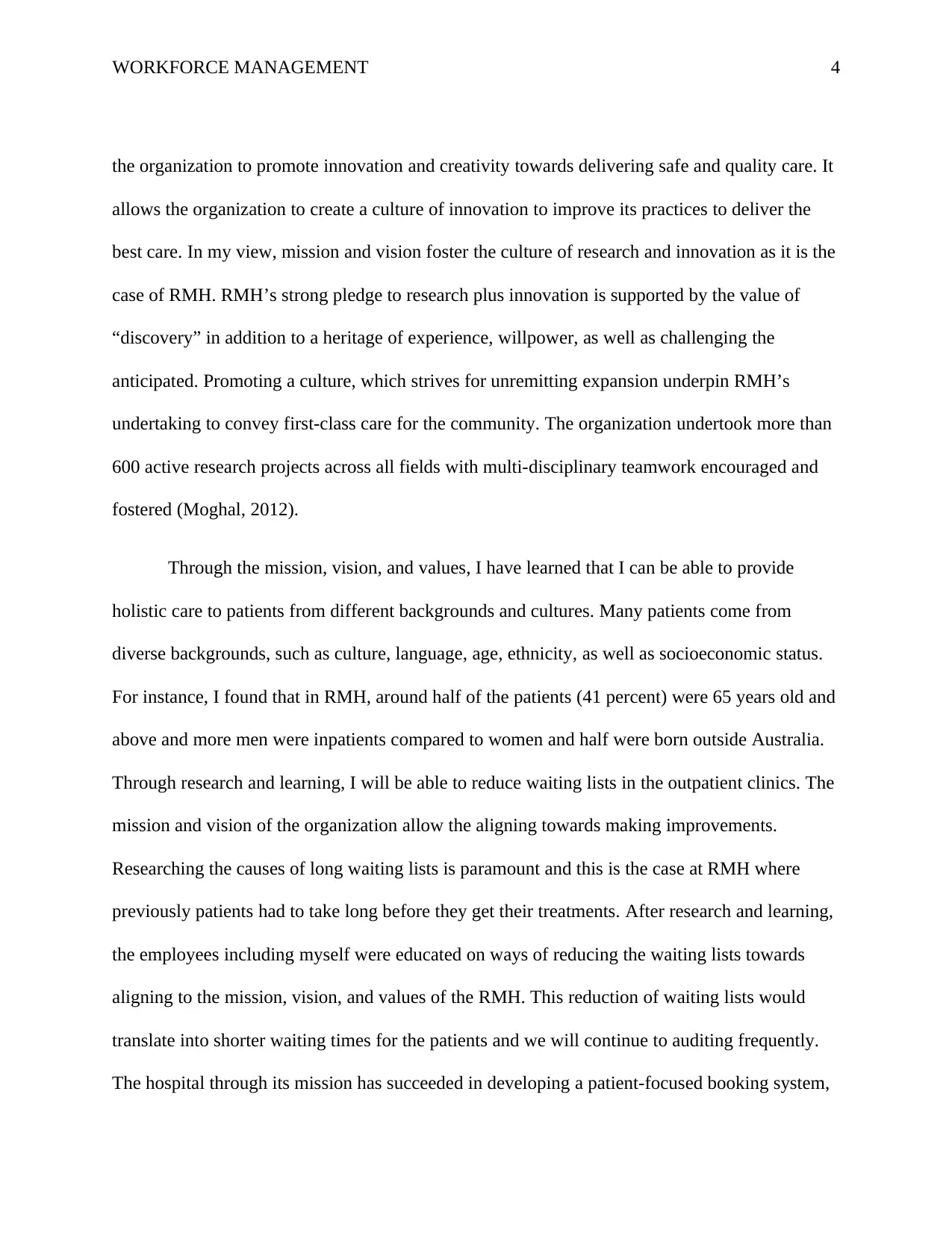
WORKFORCE MANAGEMENT 4
the organization to promote innovation and creativity towards delivering safe and quality care. It
allows the organization to create a culture of innovation to improve its practices to deliver the
best care. In my view, mission and vision foster the culture of research and innovation as it is the
case of RMH. RMH’s strong pledge to research plus innovation is supported by the value of
“discovery” in addition to a heritage of experience, willpower, as well as challenging the
anticipated. Promoting a culture, which strives for unremitting expansion underpin RMH’s
undertaking to convey first-class care for the community. The organization undertook more than
600 active research projects across all fields with multi-disciplinary teamwork encouraged and
fostered (Moghal, 2012).
Through the mission, vision, and values, I have learned that I can be able to provide
holistic care to patients from different backgrounds and cultures. Many patients come from
diverse backgrounds, such as culture, language, age, ethnicity, as well as socioeconomic status.
For instance, I found that in RMH, around half of the patients (41 percent) were 65 years old and
above and more men were inpatients compared to women and half were born outside Australia.
Through research and learning, I will be able to reduce waiting lists in the outpatient clinics. The
mission and vision of the organization allow the aligning towards making improvements.
Researching the causes of long waiting lists is paramount and this is the case at RMH where
previously patients had to take long before they get their treatments. After research and learning,
the employees including myself were educated on ways of reducing the waiting lists towards
aligning to the mission, vision, and values of the RMH. This reduction of waiting lists would
translate into shorter waiting times for the patients and we will continue to auditing frequently.
The hospital through its mission has succeeded in developing a patient-focused booking system,
the organization to promote innovation and creativity towards delivering safe and quality care. It
allows the organization to create a culture of innovation to improve its practices to deliver the
best care. In my view, mission and vision foster the culture of research and innovation as it is the
case of RMH. RMH’s strong pledge to research plus innovation is supported by the value of
“discovery” in addition to a heritage of experience, willpower, as well as challenging the
anticipated. Promoting a culture, which strives for unremitting expansion underpin RMH’s
undertaking to convey first-class care for the community. The organization undertook more than
600 active research projects across all fields with multi-disciplinary teamwork encouraged and
fostered (Moghal, 2012).
Through the mission, vision, and values, I have learned that I can be able to provide
holistic care to patients from different backgrounds and cultures. Many patients come from
diverse backgrounds, such as culture, language, age, ethnicity, as well as socioeconomic status.
For instance, I found that in RMH, around half of the patients (41 percent) were 65 years old and
above and more men were inpatients compared to women and half were born outside Australia.
Through research and learning, I will be able to reduce waiting lists in the outpatient clinics. The
mission and vision of the organization allow the aligning towards making improvements.
Researching the causes of long waiting lists is paramount and this is the case at RMH where
previously patients had to take long before they get their treatments. After research and learning,
the employees including myself were educated on ways of reducing the waiting lists towards
aligning to the mission, vision, and values of the RMH. This reduction of waiting lists would
translate into shorter waiting times for the patients and we will continue to auditing frequently.
The hospital through its mission has succeeded in developing a patient-focused booking system,
Paraphrase This Document
Need a fresh take? Get an instant paraphrase of this document with our AI Paraphraser
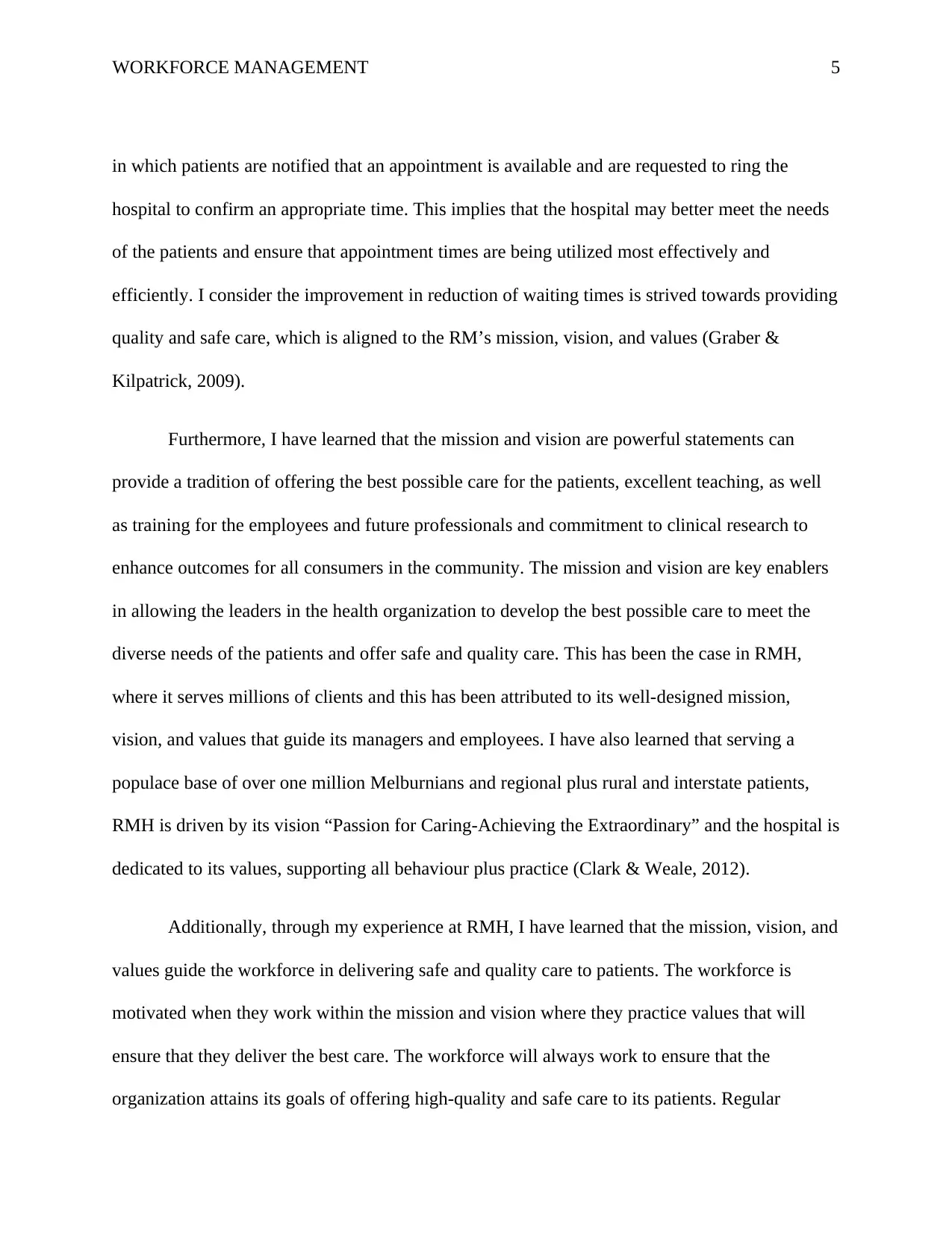
WORKFORCE MANAGEMENT 5
in which patients are notified that an appointment is available and are requested to ring the
hospital to confirm an appropriate time. This implies that the hospital may better meet the needs
of the patients and ensure that appointment times are being utilized most effectively and
efficiently. I consider the improvement in reduction of waiting times is strived towards providing
quality and safe care, which is aligned to the RM’s mission, vision, and values (Graber &
Kilpatrick, 2009).
Furthermore, I have learned that the mission and vision are powerful statements can
provide a tradition of offering the best possible care for the patients, excellent teaching, as well
as training for the employees and future professionals and commitment to clinical research to
enhance outcomes for all consumers in the community. The mission and vision are key enablers
in allowing the leaders in the health organization to develop the best possible care to meet the
diverse needs of the patients and offer safe and quality care. This has been the case in RMH,
where it serves millions of clients and this has been attributed to its well-designed mission,
vision, and values that guide its managers and employees. I have also learned that serving a
populace base of over one million Melburnians and regional plus rural and interstate patients,
RMH is driven by its vision “Passion for Caring-Achieving the Extraordinary” and the hospital is
dedicated to its values, supporting all behaviour plus practice (Clark & Weale, 2012).
Additionally, through my experience at RMH, I have learned that the mission, vision, and
values guide the workforce in delivering safe and quality care to patients. The workforce is
motivated when they work within the mission and vision where they practice values that will
ensure that they deliver the best care. The workforce will always work to ensure that the
organization attains its goals of offering high-quality and safe care to its patients. Regular
in which patients are notified that an appointment is available and are requested to ring the
hospital to confirm an appropriate time. This implies that the hospital may better meet the needs
of the patients and ensure that appointment times are being utilized most effectively and
efficiently. I consider the improvement in reduction of waiting times is strived towards providing
quality and safe care, which is aligned to the RM’s mission, vision, and values (Graber &
Kilpatrick, 2009).
Furthermore, I have learned that the mission and vision are powerful statements can
provide a tradition of offering the best possible care for the patients, excellent teaching, as well
as training for the employees and future professionals and commitment to clinical research to
enhance outcomes for all consumers in the community. The mission and vision are key enablers
in allowing the leaders in the health organization to develop the best possible care to meet the
diverse needs of the patients and offer safe and quality care. This has been the case in RMH,
where it serves millions of clients and this has been attributed to its well-designed mission,
vision, and values that guide its managers and employees. I have also learned that serving a
populace base of over one million Melburnians and regional plus rural and interstate patients,
RMH is driven by its vision “Passion for Caring-Achieving the Extraordinary” and the hospital is
dedicated to its values, supporting all behaviour plus practice (Clark & Weale, 2012).
Additionally, through my experience at RMH, I have learned that the mission, vision, and
values guide the workforce in delivering safe and quality care to patients. The workforce is
motivated when they work within the mission and vision where they practice values that will
ensure that they deliver the best care. The workforce will always work to ensure that the
organization attains its goals of offering high-quality and safe care to its patients. Regular
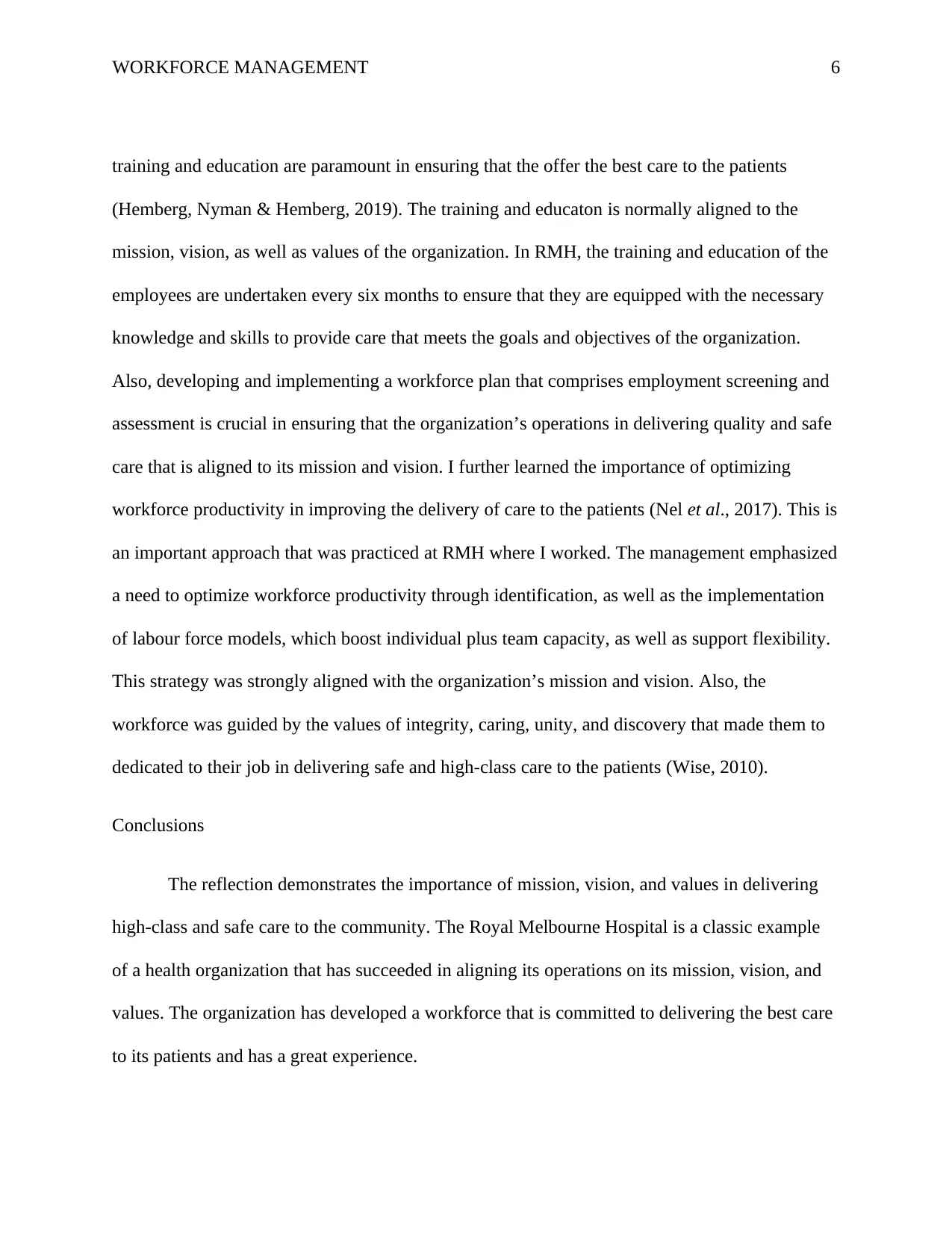
WORKFORCE MANAGEMENT 6
training and education are paramount in ensuring that the offer the best care to the patients
(Hemberg, Nyman & Hemberg, 2019). The training and educaton is normally aligned to the
mission, vision, as well as values of the organization. In RMH, the training and education of the
employees are undertaken every six months to ensure that they are equipped with the necessary
knowledge and skills to provide care that meets the goals and objectives of the organization.
Also, developing and implementing a workforce plan that comprises employment screening and
assessment is crucial in ensuring that the organization’s operations in delivering quality and safe
care that is aligned to its mission and vision. I further learned the importance of optimizing
workforce productivity in improving the delivery of care to the patients (Nel et al., 2017). This is
an important approach that was practiced at RMH where I worked. The management emphasized
a need to optimize workforce productivity through identification, as well as the implementation
of labour force models, which boost individual plus team capacity, as well as support flexibility.
This strategy was strongly aligned with the organization’s mission and vision. Also, the
workforce was guided by the values of integrity, caring, unity, and discovery that made them to
dedicated to their job in delivering safe and high-class care to the patients (Wise, 2010).
Conclusions
The reflection demonstrates the importance of mission, vision, and values in delivering
high-class and safe care to the community. The Royal Melbourne Hospital is a classic example
of a health organization that has succeeded in aligning its operations on its mission, vision, and
values. The organization has developed a workforce that is committed to delivering the best care
to its patients and has a great experience.
training and education are paramount in ensuring that the offer the best care to the patients
(Hemberg, Nyman & Hemberg, 2019). The training and educaton is normally aligned to the
mission, vision, as well as values of the organization. In RMH, the training and education of the
employees are undertaken every six months to ensure that they are equipped with the necessary
knowledge and skills to provide care that meets the goals and objectives of the organization.
Also, developing and implementing a workforce plan that comprises employment screening and
assessment is crucial in ensuring that the organization’s operations in delivering quality and safe
care that is aligned to its mission and vision. I further learned the importance of optimizing
workforce productivity in improving the delivery of care to the patients (Nel et al., 2017). This is
an important approach that was practiced at RMH where I worked. The management emphasized
a need to optimize workforce productivity through identification, as well as the implementation
of labour force models, which boost individual plus team capacity, as well as support flexibility.
This strategy was strongly aligned with the organization’s mission and vision. Also, the
workforce was guided by the values of integrity, caring, unity, and discovery that made them to
dedicated to their job in delivering safe and high-class care to the patients (Wise, 2010).
Conclusions
The reflection demonstrates the importance of mission, vision, and values in delivering
high-class and safe care to the community. The Royal Melbourne Hospital is a classic example
of a health organization that has succeeded in aligning its operations on its mission, vision, and
values. The organization has developed a workforce that is committed to delivering the best care
to its patients and has a great experience.
⊘ This is a preview!⊘
Do you want full access?
Subscribe today to unlock all pages.

Trusted by 1+ million students worldwide
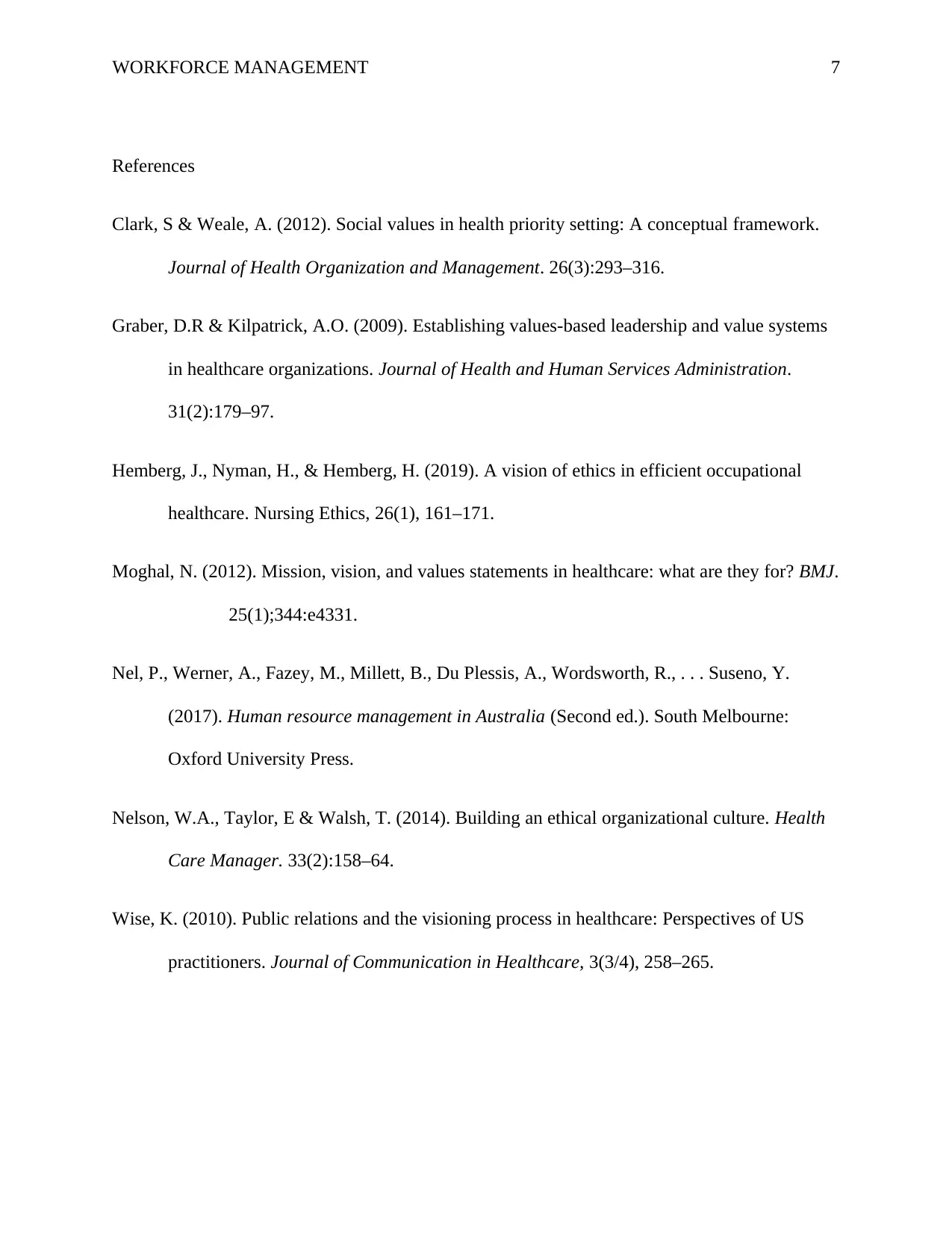
WORKFORCE MANAGEMENT 7
References
Clark, S & Weale, A. (2012). Social values in health priority setting: A conceptual framework.
Journal of Health Organization and Management. 26(3):293–316.
Graber, D.R & Kilpatrick, A.O. (2009). Establishing values-based leadership and value systems
in healthcare organizations. Journal of Health and Human Services Administration.
31(2):179–97.
Hemberg, J., Nyman, H., & Hemberg, H. (2019). A vision of ethics in efficient occupational
healthcare. Nursing Ethics, 26(1), 161–171.
Moghal, N. (2012). Mission, vision, and values statements in healthcare: what are they for? BMJ.
25(1);344:e4331.
Nel, P., Werner, A., Fazey, M., Millett, B., Du Plessis, A., Wordsworth, R., . . . Suseno, Y.
(2017). Human resource management in Australia (Second ed.). South Melbourne:
Oxford University Press.
Nelson, W.A., Taylor, E & Walsh, T. (2014). Building an ethical organizational culture. Health
Care Manager. 33(2):158–64.
Wise, K. (2010). Public relations and the visioning process in healthcare: Perspectives of US
practitioners. Journal of Communication in Healthcare, 3(3/4), 258–265.
References
Clark, S & Weale, A. (2012). Social values in health priority setting: A conceptual framework.
Journal of Health Organization and Management. 26(3):293–316.
Graber, D.R & Kilpatrick, A.O. (2009). Establishing values-based leadership and value systems
in healthcare organizations. Journal of Health and Human Services Administration.
31(2):179–97.
Hemberg, J., Nyman, H., & Hemberg, H. (2019). A vision of ethics in efficient occupational
healthcare. Nursing Ethics, 26(1), 161–171.
Moghal, N. (2012). Mission, vision, and values statements in healthcare: what are they for? BMJ.
25(1);344:e4331.
Nel, P., Werner, A., Fazey, M., Millett, B., Du Plessis, A., Wordsworth, R., . . . Suseno, Y.
(2017). Human resource management in Australia (Second ed.). South Melbourne:
Oxford University Press.
Nelson, W.A., Taylor, E & Walsh, T. (2014). Building an ethical organizational culture. Health
Care Manager. 33(2):158–64.
Wise, K. (2010). Public relations and the visioning process in healthcare: Perspectives of US
practitioners. Journal of Communication in Healthcare, 3(3/4), 258–265.
1 out of 7
Related Documents
Your All-in-One AI-Powered Toolkit for Academic Success.
+13062052269
info@desklib.com
Available 24*7 on WhatsApp / Email
![[object Object]](/_next/static/media/star-bottom.7253800d.svg)
Unlock your academic potential
Copyright © 2020–2025 A2Z Services. All Rights Reserved. Developed and managed by ZUCOL.





